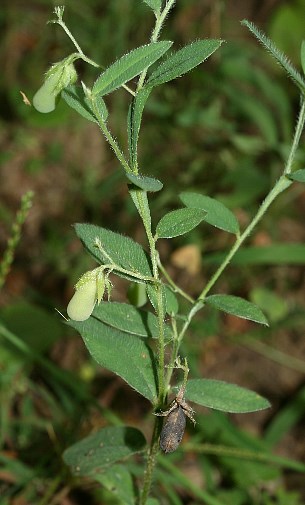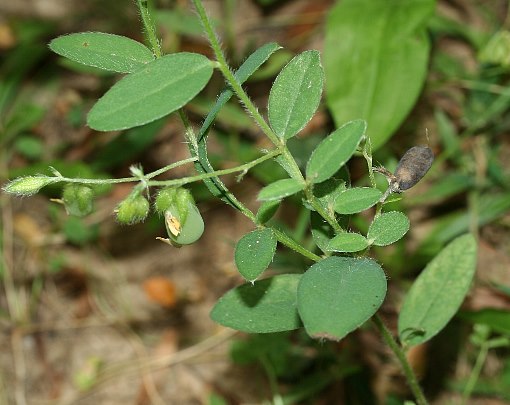Description:
This
wildflower is a summer annual about 6-12" tall that branches
occasionally; it is ascending to erect. The stems are light green,
terete, and hairy. The alternate leaves are 1–2½" long and about
one-third as much across; they are elliptic to oblong, flat, and smooth
along their margins. Both the upper and lower sides are hairy. The
upper surface is medium green, while the lower
surface is gray-green.
Each leaf has a single central vein that is prominent. The petioles are
hairy and short (less than 1/8" or 3 mm. long). Occasionally, racemes
of 1-4 flowers
are produced oppositely from some of the leaves. The peduncle (central
stalk) of each raceme is 1½–4" long, while the short pedicels of the
flowers are about
1/8" long (except the pedicel of the terminal flower, which is often
longer). Both peduncles and pedicels are hairy. At the base of each
raceme, there is a pair of large persistent stipules about ½" long.
These stipules are joined together, becoming gradually wider toward
their pointed tips. Individual flowers are about 1/3" (8 mm.) long;
they have a
typical pea-like flower structure: the yellow petals form an upright
banner and a projecting keel that is enclosed by a pair of lateral
wings. Each calyx is light green and covered with long hairs; it has
five long teeth. The blooming period occurs from mid-summer to early
fall for about 2-3 months. Usually, only a few (if any) flowers are in
bloom at the same time. The flowers are replaced by inflated seedpods
that are short-oblongoid in shape. The seedpods are initially light
green, but they later turn dark brown or black at maturity. Full-sized
seedpods are 1–1½" long and about one-third as much across; each
seedpod
contains several seeds, which can rattle if it is shook. The seeds are
distributed in part by the wind, which can blow the inflated seedpods
across open ground. The root system consists of a taproot. This
wildflower reproduces by reseeding itself.
green, while the lower
surface is gray-green.
Each leaf has a single central vein that is prominent. The petioles are
hairy and short (less than 1/8" or 3 mm. long). Occasionally, racemes
of 1-4 flowers
are produced oppositely from some of the leaves. The peduncle (central
stalk) of each raceme is 1½–4" long, while the short pedicels of the
flowers are about
1/8" long (except the pedicel of the terminal flower, which is often
longer). Both peduncles and pedicels are hairy. At the base of each
raceme, there is a pair of large persistent stipules about ½" long.
These stipules are joined together, becoming gradually wider toward
their pointed tips. Individual flowers are about 1/3" (8 mm.) long;
they have a
typical pea-like flower structure: the yellow petals form an upright
banner and a projecting keel that is enclosed by a pair of lateral
wings. Each calyx is light green and covered with long hairs; it has
five long teeth. The blooming period occurs from mid-summer to early
fall for about 2-3 months. Usually, only a few (if any) flowers are in
bloom at the same time. The flowers are replaced by inflated seedpods
that are short-oblongoid in shape. The seedpods are initially light
green, but they later turn dark brown or black at maturity. Full-sized
seedpods are 1–1½" long and about one-third as much across; each
seedpod
contains several seeds, which can rattle if it is shook. The seeds are
distributed in part by the wind, which can blow the inflated seedpods
across open ground. The root system consists of a taproot. This
wildflower reproduces by reseeding itself.
Cultivation:
The preference is full or partial sun, dry-mesic to dry conditions, and
barren soil containing sand, gravel, or clay. This wildflower is
intolerant of competition from taller ground vegetation.
Range & Habitat:
The native Rattlebox is occasional in the southern half of Illinois,
while in the
northern half of the state it is uncommon or absent (see Distribution
Map). Habitats include sand prairies, gravel prairies, clay
prairies, sandy and rocky savannas, upland savannas, rocky glades,
openings and small meadows in upland woodlands, fallow fields, and
areas along railroads. Rattlebox prefers dry open areas with a history
of disturbance.
Faunal Associations: The
flowers are pollinated primarily by long-tongued bees, including
bumblebees (Bombus spp.), Carder bees (Anthidium spp.), Cuckoo bees
(Coelioxys spp.), and large Leaf-Cutting bees (Megachile spp.).
Sometimes the flowers are visited by small butterflies or skippers, but
they are less effective at cross-pollination. The caterpillars of Utetheisa
bella (Bella Moth) feed on the foliage of Rattlebox. In
addition, there have been reports of the butterfly caterpillars of Callophrys
irus (Frosted Elfin) and the skipper caterpillars of Erynnis
baptisiae (Wild Indigo Duskywing) feeding on the foliage. The
foliage of Rattlebox is toxic to herbivorous mammals, particularly
horses, and it is generally avoided by them as a food source. However,
sometimes White-Tailed Deer chomp off the tops of individual plants.

Photographic
Location:
An upland woodland opening at Busey Woods in Urbana, Illinois.
Comments:
This is the only Crotalaria sp. (Rattlebox) in
Illinois. There are other species in this genus that are located in the
southern and western states; they are often perennials with more showy
flowers. Rattlebox is easy to identify when its inflated seedpods are
present; they are large in size in relation to the rest of the plant
and tend to stand out. There are other legumes that produce inflated
seedpods (e.g., Baptisia spp.), but they usually have compound leaves.